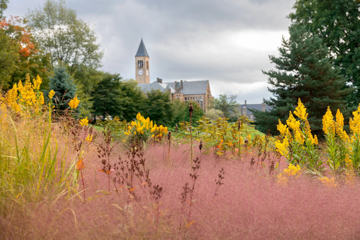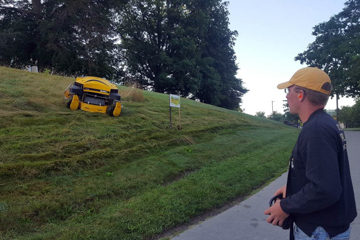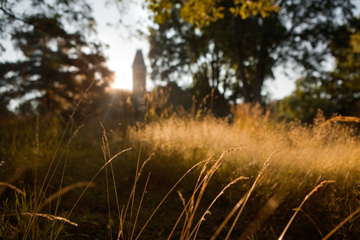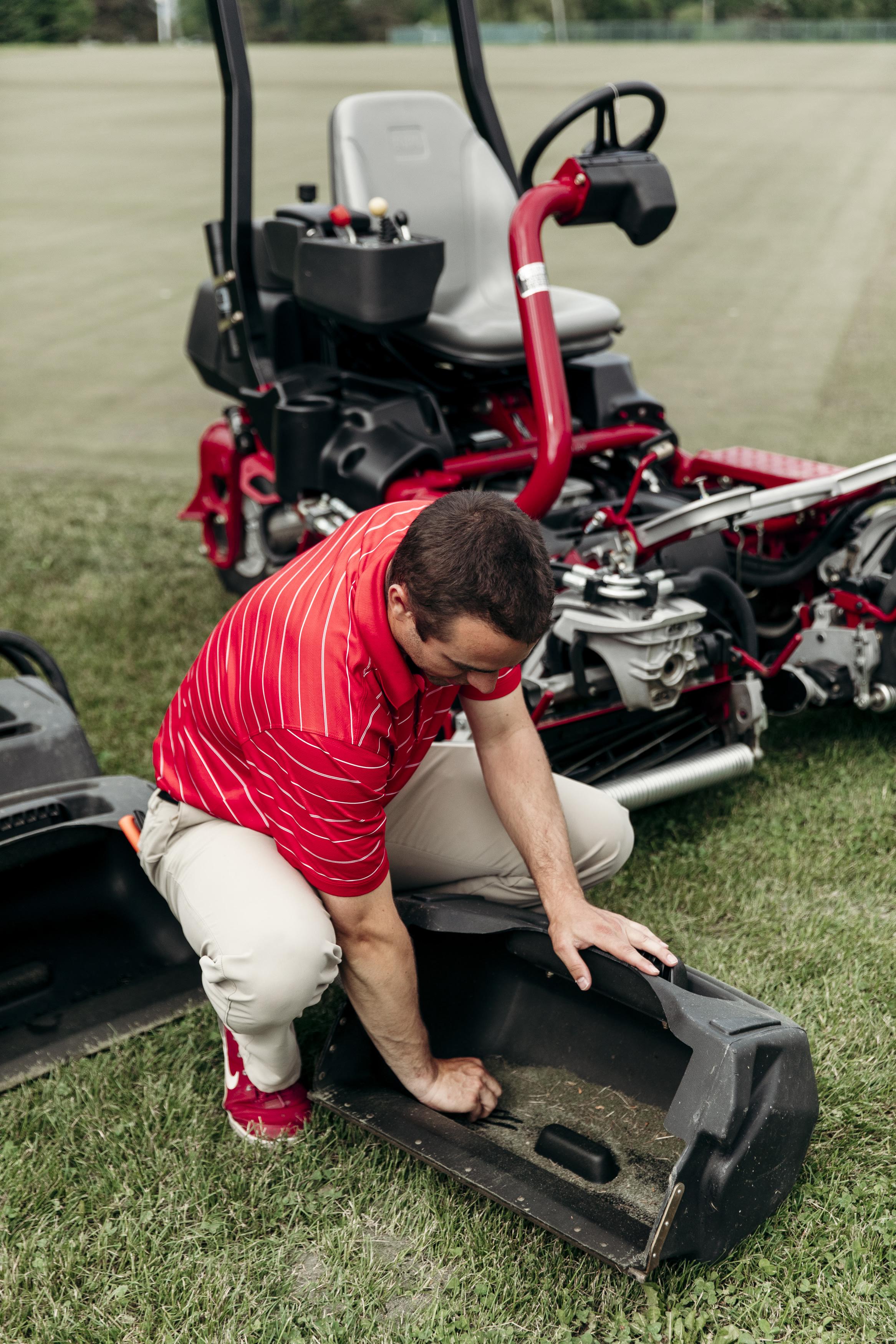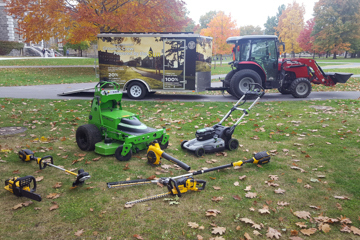As we welcome spring—with its magical flowers, shrubs, and trees budding with new life—we also welcome lawnmowing season. Before you break out the mower, we have a secret from Cornell experts to share.
Spoiler alert: This advice will save you money, fuel, time, and yield multiple environmental benefits, including: reductions in greenhouse gas emissions associated with mowing and potential increases in soil health, drainage properties, and capacity for carbon capture.
So, how do you unlock these quadruple-bottom-line rewards? The answer is simple: mow less, maybe even way less. Following the old adage “let the grass grow” may deviate from our familiar lawncare practices, but—according to the Cornell experts we consulted—the science shows it makes good sense.
“This is low-hanging fruit—it’s something you can do that doesn’t cost anything. All we do is let the grass grow.” —Grounds Department director Dan Schied
Cornell 'Meadows'
About 15 years ago, members of the University’s Grounds Department began experimenting with allowing the grass to grow in selected areas of campus. These areas were chosen because they were on steep slopes, making mowing hazardous, and/or because they didn’t have much foot traffic, so that converting them to meadows would not interfere with active recreation on campus (think frisbee).
The project was part of Cornell’s original 2009 Climate Action Plan. The goal was to reduce emissions associated with frequent mowing and thereby contribute to achieving the university’s goal of carbon neutrality by 2035.
The grounds crew started small, with less than 20 acres, but it soon became clear that this was a win-win for everyone. Grounds Department director Dan Schied estimates that the practice now applies to about 35 acres, or roughly ten percent of the mowable area on the Ithaca campus.
Instead of mowing these 35 acres regularly throughout the growing season, these plots are only mowed once a year. This practice saves the university about $50,000 annually in fuel and labor costs, and it frees up the grounds team to attend to work on projects other than mowing.
“it's a win-win on so many fronts. It saves you money, it's good for the environment, and it's good for the pollinators,” Dan observes. “A lot of times when people talk about sustainability, it costs money. So, this is low-hanging fruit—it’s something you can do that doesn’t cost anything. All we do is let the grass grow.”
Dan and staff from the Campus Sustainability Office coined the name “Tall Grass, Small Gas” for the project. They placed signs at some of the more visible sites, such as Libe Slope and the Baker Hall hill, to inform the community that the tall grass was part of an intentional program to reduce Cornell’s carbon footprint.
To date, there has been little pushback from the Cornell community, Dan reports. The fact that the areas are still mowed once a year helps to keep woody plants from establishing themselves in the meadows. Dan works with stakeholders across campus to identify new areas for inclusion, such as the Cornell Dyce Lab for Honeybee Studies, which was added last year.
“It just takes time to educate people,” Dan says. “They have to see little bits and pieces, you know, and I think the Tall Grass project offers people the opportunity to start doing that.”
Quantifying the benefits through research
In addition to the benefits that Dan cites, Cornell researchers have been investigating the Tall Grass initiative to determine longer-term ancillary benefits. In 2022, the Sustainable Cornell Council assembled a carbon sinks working group to think through how to manage Cornell lands in ways that reduce greenhouse gas emissions.
Carl Schimenti ’14, a CALS researcher in the School of Integrative Plant Science specializing in urban grasslands, began working with Dan to quantify the emissions reductions associated with the Tall Grass initiative. Carl refers to the lands in the project as Cornell ‘meadows.’
“These areas are mowed only 1 time per year, versus 25 times for a regularly mown area. Based on fuel use in those two scenarios, each hectare of tall grass area results in a reduction of 310 kg (277 pounds) CO2 per year,” Carl explains.
Just based on reduced fuel use, the tall grass initiative reduces Cornell’s CO2 emissions by a total of 9,700 pounds per year. (For comparison, that is equal to the emissions from driving nearly 11,000 miles in an average gasoline powered vehicle, or the amount of CO2 sequestered by 5 acres of forest in one year.)
Tall grass also eliminates the need to apply nitrogen fertilizer—thereby eliminating emissions of nitrous oxide (N2O), a greenhouse gas with a warming potential 300 times larger than CO2. Carl estimates that reduction in greenhouse gas emissions by eliminating fertilizer use in these areas is between 250 and 500 kg CO2 per hectare per year—or roughly similar to the fuel use reductions.
Kyle Wickings, an associate professor in the entomology department, is also studying whether the meadows are capable of increasing carbon storage below ground relative to the standard lawn. His research will examine how increased mowing height and reduced mowing frequency affect below ground biodiversity.
“The prediction is that with reduced mowing intensity, we'll create deeper root systems and more stable, porous soils—and, with them, greater habitat suitability for below-ground critters,” Kyle explains. “Soil animals are known to enhance nutrient cycling and encourage the incorporation of fresh organic matter into more stable carbon pools below ground. Our question is whether these practices can increase our ability to use lawns as reservoirs for carbon, soil biodiversity, and water.”
Along with emissions reductions, cost savings, and enhanced biodiversity, another co-benefit of meadows is that they help control stormwater runoff. Carl says that during large rain events, they slow the speed of runoff water and promote infiltration into the soil.
“In my extension work, I’ve encountered several communities who want to manage their turfgrass in a more sustainable fashion, and I can use this work at Cornell as a template,” Carl observes. “Over time, Cornell can encourage adoption of these practices on a state or regional scale. There’s a broad impact we can have that touches many other facilities and institutions.”
Bringing the science home
Carl and Dan agree that the lessons learned from the Tall Grass initiative can directly translate into more sustainable groundskeeping practices at home. They recommend the following tips for managing your own property:
- Sharpen your mower blades. Dull mower blades can increase fuel usage up to 20%, so be sure to sharpen those mower blades at least once per year.
- Raise that mowing height. We estimate that raising your mowing height 1 inch can reduce your mowing frequency by 20%. The goal is to mow off no more than 1/3 of the leaf. This is called the ‘1/3 rule’ and it matters because when you mow off more than 1/3 of the leaf blade, the turf experiences stress that leads to decreased drought and heat tolerance. Set the mowing height at the least to 3 inches, and preferably just raise it as high as it will go.
- Return the grass clippings. Also called “grass cycling,” it simply means you should take the bag off the mower and allow the grass to be mulched back into the lawn. This returns nutrients in those grass clippings back into the soil and leads to a reduction in fertilizer needs.
- Mow your leaves. Rather than raking up, bagging, and disposing of your leaves, leave them in place and mow them. The leaf litter adds organic matter to your soil, enhancing soil health.
- Let the grass grow. Good candidates for no- or low-mow areas are steep slopes and areas with low traffic. For those interested in water quality, vegetative buffers where water runs off have been shown to reduce sediment and nutrient pollution. Tall grass buffers of 5 to 10 feet work well around drainage ditches and should be mown in the fall to control weeds (when the fewest grassy weeds are germinating). Be sure to check with your local municipality regarding regulations that may restrict this in your location.
Electrify your equipment. Lawn mowers, weedeaters, and backpack blowers can now be replaced by battery-powered units that reduce harmful emissions. Co-benefits include financial savings from elimination of fuel use, noise reduction, reduced equipment maintenance, and possible integration of solar to power equipment through renewable energy.

